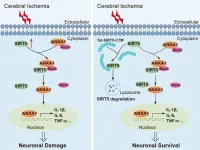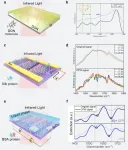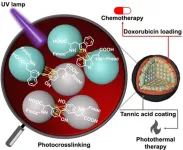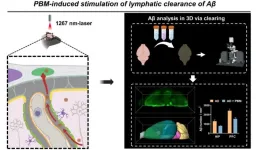(Press-News.org) A combination of only 11 proteins can predict long-term disability outcomes in multiple sclerosis (MS) for different individuals. The identified proteins could be used to tailor treatments to the individual based on the expected severity of the disease. The study, led by researchers at Linköping University in Sweden, has been published in the journal Nature Communications.
“A combination of 11 proteins predicted both short and long-term disease activity and disability outcomes. We also concluded that it’s important to measure these proteins in cerebrospinal fluid, which better reflects what’s going on in the central nervous system, compared with measuring in the blood,” says Julia Åkesson, doctoral student at Linköping University and the University of Skövde.
In multiple sclerosis, the immune system attacks the person’s own body, damaging nerves in the brain and in the spinal cord. What is attacked primarily is a fatty compound called myelin, which surrounds and insulates the nerve axons so that signals can be transmitted. When myelin is damaged, transmission becomes less efficient.
Disease progression in multiple sclerosis varies considerably from person to person. To those for whom a more severe disease is predicted, it is important not to lose valuable time at the onset of the disease but to get the right treatment quickly. The researchers behind the current study, which is a collaboration between Linköping University, the Karolinska Institute and the University of Skövde, wanted to find out whether it was possible to detect at an early stage of disease which patients would require a more powerful treatment. Being able to do so would be relevant both to physicians and those living with MS.
“I think we’ve come one step closer to an analysis tool for selecting which patients would need more effective treatment in an early stage of the disease. But such a treatment may have side effects and be relatively expensive, and some patients don’t need it,” says Mika Gustafsson, professor of bioinformatics at the Department of Physics, Chemistry and Biology at Linköping University, who led the study.
Finding markers linked to disease severity many years ahead is a complicated challenge. In their study, the researchers analysed nearly 1,500 proteins in samples from 92 people with suspected or recently diagnosed MS. Data from the protein analyses were combined with a large amount of information from the patients’ journals, such as disability, results from MRI scans of the nervous system, and treatments received. Using machine learning, the researchers found a number of proteins that could predict disease progression.
“Having a panel consisting of only 11 proteins makes it easy should anyone want to develop analysis for this. It won’t be as costly as measuring 1,500 proteins, so we’ve really narrowed it down to make it useful for others wanting to take this further,” says Sara Hojjati, doctoral student at the Department of Biomedical and Clinical Sciences at Linköping University.
The research team also found that a specific protein, leaking from damaged nerve axons, is a reliable biomarker for disease activity in the short term. This protein is called neurofilament light chain, NfL. These findings confirm earlier research on the use of NfL to identify nerve damage and also suggest that the protein indicates how active the disease is.
One of the main strengths of the study is that the combination of proteins found in the patient group from which samples were taken at Linköping University Hospital was later confirmed in a separate group consisting of 51 MS patients sampled at the Karolinska University Hospital in Stockholm.
This study is the first to measure such a large amount of proteins with a highly sensitive method, proximity extension assay, combined with next-generation sequencing, PEA-NGS. This technology allows for high-accuracy measuring also of very small amounts, which is important as these proteins are often present in very low levels.
The study was funded by the Swedish Foundation for Strategic Research, the Swedish Brain Foundation, Knut and Alice Wallenberg Foundation, Margaretha af Ugglas Foundation, the Swedish Research Council, NEURO Sweden and the Swedish Foundation for MS research, and others.
Article: Proteomics reveal biomarkers for diagnosis, disease activity and long-term disability outcomes in multiple sclerosis, Julia Åkesson, Sara Hojjati, Sandra Hellberg, Johanna Raffetseder, Mohsen Khademi, Robert Rynkowski, Ingrid Kockum, Claudio Altafini, Zelmina Lubovac-Pilav, Johan Mellergård, Maria C. Jenmalm, Fredrik Piehl, Tomas Olsson, Jan Ernerudh and Mika Gustafsson, (2023), Nature Communications, published online as open access on 30 October 2023, doi: 10.1038/s41467-023-42682-9
END
Severe MS predicted using machine learning
2024-01-09
ELSE PRESS RELEASES FROM THIS DATE:
Combining anti-tumor drugs with chemo may improve rare children’s cancer outcomes
2024-01-09
Children who develop neuroblastomas, a rare form of cancer which develops in nerve cells, may benefit from receiving certain anti-tumour drugs as well as chemotherapy, a new trial has found.
The results of the BEACON trial conducted by the Cancer Research UK Clinical Trials Unit at the University of Birmingham found that combining anti-angiogenic drugs, which block tumours from forming blood vessels, alongside various chemotherapy drugs led to more young people seeing their tumours shrinking, from 18% in the control group to 26% among those on Bevacizumab.
The findings are published in the Journal of Clinical Oncology today. The trial saw 160 young ...
EBRAINS research infrastructure secures €38 million in funding for new phase of digital neuroscience
2024-01-09
The European Commission has accepted the EBRAINS 2.0 proposal submitted in response to the INFRASERV call, granting €38 million for the further development of services of the EBRAINS research infrastructure.
The European Commission has signed a grant agreement to fund EBRAINS with €38 million until 2026. Over the next three years, the infrastructure will continue to develop tools and services to widely serve research communities in neurosciences, brain medicine, and brain-inspired technologies.
EBRAINS (European Brain Research Infrastructures) is an EU co-funded collaborative research platform designed to advance neuroscience and brain ...
Train your brain to overcome tinnitus
2024-01-09
An international research team has shown that the debilitating impact of tinnitus can be effectively reduced in just weeks by a training course and sound therapy delivered via a smartphone app.
The team from Australian, New Zealand, French and Belgian universities report these findings today in Frontiers in Audiology and Otology.
It offers some hope for millions affected by tinnitus who:
have been told that there is nothing they can do about it
face long queues waiting for treatment, or
can’t afford the costs of specialist support.
The initial trial worked with 30 sufferers, of whom almost two thirds experienced a ‘clinically ...
A chemical reaction key to various industries just got greener
2024-01-09
Osaka, Japan – From alleviating your allergy symptoms to optimizing herbicide performance, alkylamines are molecules that have many uses. Unfortunately, common methods of producing alkylamines result in harmful waste byproducts. A method of synthesizing alkylamines in a sustainable yet cost-effective way has thus been highly sought after.
Now, in a study recently published in Green Chemistry, a research team led by Osaka University has found a way. The team has developed a method of alkylamine synthesis that works under mild conditions and produces ...
Spanish butterflies better at regulating their body temperature than their British cousins
2024-01-09
Butterfly populations in Catalonia in northern Spain are better than their UK counterparts at regulating their body temperature by basking in the sunshine, but rising global temperatures due to climate change may put Spanish butterflies at greater risk of extinction.
An international study, led by the University of Cambridge and the Institut de Biologia Evolutiva (IBE) in Barcelona, found that butterflies use different methods to regulate their body temperature. In Catalonia, butterflies tend to angle ...
A novel cell-penetrating peptide exerts therapeutic effects against ischemic stroke
2024-01-09
This study is led by Dr. Xing Li and Dr. Yilin Zhao (Department of Anesthesiology, Hubei Key Laboratory of Geriatric Anesthesia and Perioperative Brain Health, and Wuhan Clinical Research Center for Geriatric Anesthesia, Tongji Hospital, Tongji Medical College, Huazhong University of Science and Technology). The team's previous research found that the increase in SIRT5 in microglia induced by ischemic stroke causes annexin-A1 (ANXA1) desuccinylation, which decreases ANXA1 membrane recruitment and secretion but promotes ANXA1 nuclear translocation, resulting in the production of proinflammatory ...
Ultrasensitive molecular sensing with synthesize complex-frequencey waves
2024-01-09
Sensors are essential tools for detecting and analyzing trace molecules in a variety of fields, including environmental monitoring, food safety, and public health. However, developing sensors with high enough sensitivity to detect these tiny amounts of molecules remains a challenge.
One promising approach is surface-enhanced infrared absorption (SEIRA), which uses plasmonic nanostructures to amplify the infrared signals of molecules adsorbed on their surface. Graphene is a particularly promising material for SEIRA because of its high ...
Creating novel amino acid nanoparticles with enhanced anticancer activity
2024-01-09
Ishikawa, Japan -- Amino acids, such as tyrosine and tryptophan, are the fundamental building blocks that make up proteins. These biomolecules have different chemical groups on each end and side chain, and so, have the natural ability to form a chain through the formation of an amide (peptide) bond. However, such linkages are weak and easily degraded under physiological conditions. This is where the Fmoc-protected amino acids come into the picture.
In a new study now, a research team led by Dr. Eijiro Miyako, Associate ...
A landscape-based approach to urban heritage management: People, spatial biography, and ecosystem
2024-01-09
This article first identifies the current definition of urban heritage that includes both “old” and “young” monuments. Their protection has also shifted from solely preserving “old” values into a more holistic process to retain “old” values and manage the change in their adaptive reuse to gain “new” values, towards a more people-centered and landscape-based approach. Furthermore, a concept of ecosystem for urban planning and development is introduced, ...
Photostimulation: non-invasive and effective therapeutic approach for Alzheimer’s disease
2024-01-09
Alzheimer’s disease (AD) is an age-related neurodegenerative disorder. β-amyloid (Aβ) deposition in the brain is a crucial contributor to the pathogenesis of AD, mitigating excessive cerebral Aβ burden has been considered as a possible therapeutic strategy for AD. Meningeal lymphatic vessels (MLVs) are recently discovered structures responsible for exchanging soluble components between the cerebrospinal fluid and interstitial fluid, and have been proved to be a potential pathway of Aβ drainage.
Researchers at Huazhong University ...











